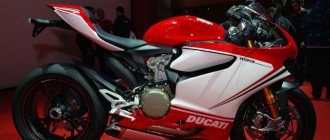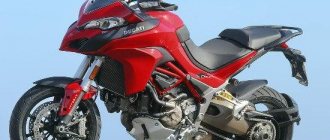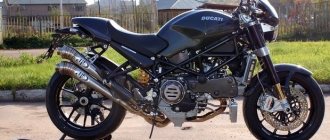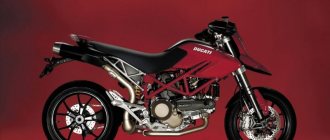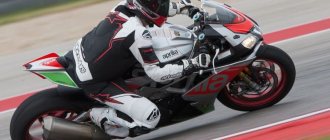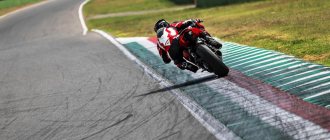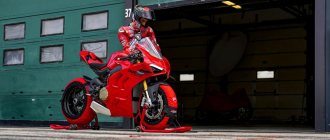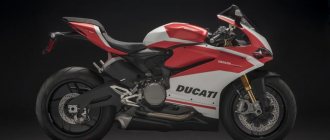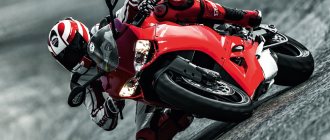With the launch of the new Ducati Panigale 1299 S superbike, Ducati continues to demonstrate its commitment to the principle “Nothing replaces displacement”. Powered by a 1285cc L-twin Superquadro engine, Ducati's latest superbike has been designed for riders who want all the performance possible from the Italian marque. In order to understand whether the Panigale 1299 S from Ducati meets these requirements, I took a test drive of the superbike along the coast.
First ride on Ducati Panigale 1299 s 2015
About increasing the torque of the Ducati engine
Ducati's superbikes had long been renowned for their low- and mid-range torque until 2012's high-revving Panigale 1199, whose low-end torque band was trimmed in favor of a top-end power curve. At first I was skeptical about Ducati's decision to increase the torque of the new bike's engine by widening the cylinder bore by 4mm, rather than the usual method of increasing the piston stroke. But as soon as I rode this motorcycle, all my skepticism disappeared. And now I'm happy to tell you that mid-range torque is back.
Ducati said torque between 5,000 and 8,000 rpm has increased by 15% compared to its predecessor. This seems to be true, as the 1299 now zips through corners sharper and faster than before. The engine of the new superbike has a displacement of 87 cubic centimeters more than its predecessor. Also on 1299, the pressure air intake nozzles have become larger. And the diameter of the exhaust manifolds has increased by 4mm.
The Ducati Panigale 1299 s absolutely loves high revs, but the added mid-range torque does mean some restraint in its riding style. As before, the new Panigale produces excellent torque in the top range and its power is impressive.
The last time I dyno-tested the Panigale 1199, it showed 165 horsepower being sent to the Pirelli SP tire. The Panigale 1299 s began to show another 10 additional horsepower. As before, Ducati has equipped the motorcycle with 3 ignition maps (Race - high, Sport - medium, Wet - low), which allows the driver to adjust engine operation depending on the condition of the road surface or personal preferences.
TEST DRIVE - DUCATI 1299 Panigale R Final Edition. What kind of motorcycle is this?
Just the other day, the head of the MCN magazine test drive team, Michael Nieves, took a test ride on the DUCATI Panigale 1299 R Final Edition motorcycle. We will try to convey his impressions and reviews of this unique bike.
The final release of this model combines all the best characteristics and achievements of DUCATI in the creation of sport bikes. The most technologically advanced solutions are borrowed from the current range of Panigale models and successfully applied in the developed motorcycle.
The DTC electronic assistant (EVO) is taken from the modern version of the 1299 Panigale, the aluminum monocoque frame, adjustable swingarm, forged wheels, suspension and brakes are borrowed from the Panigale R series. But perhaps one of the most important differences is the engine. Peak power of 209 hp. With. is achieved at 11,000 rpm and an incredible torque of 141 Nm - at 9,000 rpm.
DUCATI 1299 Panigale R Final Edition can be purchased at the MOTORRIKA motorcycle showroom (official DUCATI dealer in Russia)
Attention! The only copy in Russia is only in our showroom. More details »
In the photo: the handsome bike is ready for racing!
The bike may cost almost double the base model 1299 Panigale, but dressed in a striking carbon livery, the beauty is worth the money.
As with all large-volume Panigale models, on the track you should keep the engine in the high rev range, playing with short gears to achieve maximum dynamics. Without the use of a carbon chassis, the Final Edition would be only half a kilo lighter than the base 1299, which does not prevent the bike from cutting critical corners and swallowing straight tracks with monstrous acceleration. You only need to hear the rich exhaust sound of the Final Edition once on a straight track, and this is more than enough to “get sick” of this motorcycle.
It should be admitted that the 1299 Panigale R Final Edition model still does not tear from under the rider at the start, and does not have such sophisticated antiwheelie and traction control as its track-oriented brothers. However, at the same time, the electronic rider assistance systems installed on the bike have one of the highest levels of progressiveness, and in combination with a balanced chassis and engine power, they are able to show decent results on the track.
Pictured: rear adjustable suspension
The Final Edition motorcycle is slightly different from the base model 1299 Panigale, but the main characteristics are similar: a high-compression piston group, camshafts with increased cam lift, a lightweight flywheel and crankshaft with tungsten counterweights, titanium connecting rods, as well as intake and exhaust valves, lightweight lithium battery. The Akrapovic titanium under-seat exhaust is fairly quiet compared to the stock Panigale's outboard exhaust, so it's perfect for zipping around town without bothering everyone around you.
It has come a long way from the wayward original, the 1199. The 2012 bike reacted harshly and uncompromisingly to the slightest hint of throttle opening and generally behaved quite wayward. The 1299 Panigale R Final Edition has friendlier chassis tuning and more refined DTC electronic assistant (EVO) settings. The sportbike still feels confident and insanely fast, but now that speed is under tangible control of the rider.
In the photo: turns are easy and relaxed
The bike still favors a certain riding style; its own special style of riding on the track is incomparable with other sportbikes. The bike hates wide steering angles, sloppy throttle and brake drag when cornering, and still bucks in protest when ridden rough and clumsy. It rewards the rider who manages to understand the intricacies of the controls with unrestrained acceleration, crazy cornering angles, and can change direction from curb to curb faster than lightning on difficult sections of the track.
At the moment of emergency braking, no sportbike will show such a smooth and confident reduction in speed, will not allow the rider to feel as relaxed as the DUCATI 1299 Panigale R Final Edition does.
The model was created in the best traditions of the manufacturer and, as always, amazes with its equipment and stunning appearance. Consider the Bosch IMU inertia measurement system, ABS, DWC EVO and DTC EVO electronic assistants for the best control and stability of the bike. Forged wheels, ÖHLINS suspension, monobloc Brembo calipers and graceful contours of a carbon livery, richly painted in the colors of the Italian tricolor - DUCATI once again confirms its belonging to the world elite of motorcycle manufacturers and its signature style.
Steering the Panigale just got easier
On the motorcycle, the steering rack angle was reduced by half a degree and it was also lowered by 4 mm. The 1299 zips through corners with an agility you wouldn't expect from a superbike sportbike. The wheelbase of the motorcycle has become shorter by 4 mm. But perhaps the most impressive feature is how wonderfully tuned the chassis is for cornering. Particularly impressive is the bike's mid-corner performance. The bike passes them so deftly that in order to get used to it you will need to ride several laps on the track.
The Ducati Panigale 1299 features a cast aluminum inverted double-sided adjustable swingarm. The excellent suspension makes the bike hold the road during any maneuvers.
The Panigale 1299 S version is distinguished by the fact that it is equipped with an electronically adjustable Ohlins steering damper, the main task of which is to reduce fork vibration in corners to nothing. A not-so-noticeable but still very important update is the new pegs, which are shaped to give your boots and pegs more grip. Another difference is that the windshield is mounted higher than on last year’s bike.
Ohlins smart e-suspension
Ducati has equipped the Panigale 1299 S with Ohlins semi-active electronic suspension. The suspension works in conjunction with an IMU (Inertial Measurement Unit), which includes gyroscope and accelerometer functions. The suspension has 2 modes - fixed and event. In addition, the driver can choose one of 5 damping modes (Softest, Softer, Default, Harder and Hardest), which regulate the operation of the fork, shock absorber and steering damper.
Due to the limited time of my test drive and so many electronics tweaks on this Panigale, I only drove it on the Default setting. As already mentioned, the motorcycle chassis is made in such a way that it really asks the driver for speed. But there is no doubt that the Hardest setting will give a more favorable result. But, unfortunately, I didn’t have enough time to ride this mode...
DWC Rear Wheel Control System
Although the company is an innovator in sports motorcycle electronics, Ducati superbikes are not typically equipped with Wheelie Control. There have been a lot of complaints from riders about this over the past few years. Now Ducati has responded to those dissatisfied by installing DWC (Ducati Wheelie Control) on the new bike. The DWC system relies on data received from the IMU to adjust engine power output when it detects excessive front wheel lift. The system includes 8 settings (level 8 is the maximum electronic control, 1 is the minimum) that allow the rider to adjust the degree of lift of the front wheel during acceleration.
I tested the DWC system and I can say that the Ducati electronics failed to impress me much, as they showed rather inconsistent results. I tried various settings from level 3 to 8 and never felt adequate control from the system. I believe that the usefulness of DWC on a bike is minimized because the rider is still required to let go of the throttle to manually control the amount of front wheel lift to maintain balance.
In general, I only liked mode 7, in which the DWC system still showed its work. While I appreciate Ducati adding DWC control to its electronics arsenal, the company should reconsider the system for its actual usefulness. One of the features I liked is that the bike has a handlebar mounted switch that allows the rider to adjust the DWC and traction control while riding.
Ducati 1299 Panigale S: fully equipped with Pirelli and Ohlins (+ video)
Just in Portugal, on the world track Autódromo Internacional do Algarve (Portimao), another series of tests of the brand new Ducati 1299 Panigale S was completed: a motorcycle that does not fit into the format of any racing series is capable of giving more than Superbike.
MOTOGONKI.RU, January 26, 2015 — It was immediately dubbed “Supercommuter,” that is, a motorcycle for every day with the prefix “super.” Unlike the production 1199 Panigale S and its racing version 1199 Panigale R, the 1299 has no racing future. And therefore, the developers had a free hand on what exactly to give to thrill-hungry clients. And they were given everything that Ducati has in its arsenal!
Ducati 1299 Panigale S (2015)
Pirelli announced the extension of the contract for the supply of Diablo Supercorsa SP series tires to the Borgo Panigale assembly line. In 2012, Italian tire makers presented this model at the end of the year, at the EICMA exhibition in Milan, as an exclusive model for the Panigale size 200/55 R17, promising to bring other sizes of rear cylinders to the market next year. And since 2014, these tires have been used in races of various national championships, as well as as an option in the FIM Superstock-1000 World Cup. Developed by WSBK, these tires have a significantly stiffer carcass and a profile that is 23% wider than the previous version. A feature of the SP series tires is the so-called “slick” area on the edge of the tire - an additional 30 mm of “meat” of the softest compound, which allows you to tilt the motorcycle lower in turns without fear of losing grip on the very edge.
This solution could not have been better suited for the Ducati 1299 Panigale S, an extremely charged road bike. After all, now an advanced pilot can easily realize its potential.
"1299" was shown to the public at an official presentation on the evening of Monday, November 3 in Milan. Its purpose, according to the President of the Holding, is to impress others and delight oneself: the electronic package of the “S” version contains all the developments that Ducati Corse has in the arsenal in MotoGP and World Superbike racing, with the exception of the most expensive ones (like seamless transmission).
Ducati 1299 Panigale torque and power curves compared to 1199 Panigale
The 1285 cc desmodromic V-Twin, which is the supporting part of the monocoque chassis (like the Ducati Desmosedici GP3), is controlled by a single computer system, which includes eight independent control units. And all this may actually be required, because the engine is capable of producing more than 200 hp not only on paper, but on a dyno. and 144 Nm of torque at the rear wheel! With all this, 1299 began to weigh even less than 1199.
Ohlins Smart EC Automatic Suspension Controller
The latest version of Bosch 9.1 MP ABS is connected directly to the ECU (engine control unit), motorcycle position sensors and GPS, which together form an “inertial platform” for information analysis and operational decision making. The key to this platform is the IMU or Inertial Measurement Unit, as a co-processor that complements the functions of the main controller. Next comes Ducati Traction Control (DTC), Ducati Quick Shifter (DQS), Engine Braking Control (EBC) and Ducati Wheelie Control (DWC). Each unit performs its own function, but constantly communicates with the IMU and ECU, receiving final “instructions” from it.
Ohlins TTX 36 MkII EC has become an integral part of the Ducati Panigale S package
An integral part of the network is the semi-automatic suspension - the Ohlins Smart EC package with its own Mechatronic control unit. The basic active chassis kit for the Ducati 1299 Panigale S includes four elements: an Ohlins NIX-30 blade with electronically controlled 30mm cartridges; Ohlins TTX 36 MkII EC monoshock; an electronic steering damper and the controller itself, working in tandem with the IMU. The system is topped by a Ducati Data Analyzer (DDA+ with GPS) for collecting and analyzing telemetry information.
Not only the suspension, but also the steering damper of the Ducati 1299 Panigale S is electronically controlled
The Ducati 1290 Panigale S with all this “weaponry” costs about €28,000, ahead in price of all existing Factory superbike models (in the basic configuration), including the Aprilia RSV4 APRC, BMW HP4, Honda Fireblade SP and even the Yamaha R1M. But they are unlikely to ever meet on the same track: according to the good old tradition, Ducati creates its own class of motorcycles - just for fun! What is all this attachment for and how does 1299 differ from the previous 1199? Journalists from the world's motorcycle publications tried to answer this question in Portimao last weekend.
“The bike is even stiffer and handles more precisely, thanks to a fraction of a degree lower fork angle,” writes MCN's Mark Potter. — The new fairing contains important improvements that improve aerodynamics: it is needed because the motorcycle reaches the air, perhaps too early. Many of us have been to the track in Portimao before, but today the track and trajectories had to be re-learned: the explosive nature of the 205-horsepower engine bursts out in all six gears. There is no need to wait for the “moment of power” to arrive - energy flows to the rear wheel instantly and in abundance: the motorcycle continues to accelerate in a stable wheelie after climbing the hill at the beginning of the finish line, the front wheel does not fall on the asphalt until the very end, after 500 meters . It took some time to set up the wheelie control, since this element of electronics is now not just an accessory, but a necessary feature originally from MotoGP.”
Ducati 1299 Panigale S (2015) tested in Portimao
Potter continues: “This bike has a lot of crossovers with MotoGP. Ducati clearly wanted to let us non-sport riders know what it was like to ride a prototype. The clutch-less downshift system comes from there. This is incredible! 4-5 control units come into play at the same time, ranging from DQS with DTC to the new engine braking system. The controllability of the motorcycle - it feels like - is just off the charts. We didn't use the ABS much in the corners, clearly pushing the limits, but it's nice to know it's available and can come to your aid. I don’t dare to draw any far-reaching conclusions, because I spent only a few sessions in the saddle, but... I’m overwhelmed with emotions!”
Going through the list of electronics involved is “boring,” says test driver Luke Bowler. It's much more interesting how the bike tastes, for example, compared to the 1199 Panigale S, isn't it?
Ducati 1299 Panigale S (2015)
“We are all well aware of the reputation of the 1199 as a very twitchy and harsh sporting equipment,” Bowler wrote on his blog. “If you couldn’t cope with it before, no amount of poultices and hours of vigil in search of settings would help you. With a new engine that sticks out 10% more, you still have to do higher mathematics and delve into the algorithms of the electronic modules, because they are all tuned to only one topic - to help the pilot in the fight against this bird. Like the 1199, it has traction control and engine braking, but now adds wheelie control and an aggressive system for downshifting and even upshifting without letting off the throttle! That’s what really sticks.”
“Dig deeper, the 1299 S is ideal for Portimão, with its hills and many blind corners. The semi-active Ohlins suspension and electronically controlled steering damper do their job to perfection, plus the lighter rims installed on this model begin to play a role. Portimão is a very physically demanding track, and a bike as tough as the Panigale always feels good in its hairpins and rollercoaster rides, but only if you're willing to hold on until the end. This was the case with the 1199. But, probably, the main difference from the 1199 was that you no longer need to wring all the juice out of the motorcycle so that it maintains the trajectory at the exit - the power flows to the wheel throughout the entire rev range, you can enjoy the overloads even at average pace."
“The 1299 gearbox has been improved - soft and clear, it reminded me more of the gearbox of the new BMW S1000RR MY15. As for the exhaust sound, the one the Ducati generates gives me goosebumps: the sound of a V-Twin with pistons the diameter of a pancake plate has always been more dramatic than that of the Japanese in-line. For this and a few other reasons, if you show up to the party on Friday night in the saddle of 1299, you will have the full attention of the crowd,” concluded Bowler.
Compiled and prepared by Kirill Chernyshev, photo by Ducati Images and Pirelli
Corner ABS and DQS
From the items themselves to their settings, I'm a big fan of the functionality and braking prowess of the Panigale range, and the 2015 model's braking system looks even more advanced with new corner ABS. The basis of this system is the updated version 9.1 of the wonderful 9ME ABS controller from Bosch, which is 1 kilogram less than the previous set. The Bosch module also monitors the tilt angle (again, relying on the IMU).
The system is activated at ABS levels 2 and 3, but is not activated at level 1, at which the rear brake ABS is also disabled. Overall, corner ABS works well, although I didn't drive the Panigale hard enough to properly detect its intervention. However, I did notice that the brakes felt noticeably less harsh with the system engaged. So with my riding style I liked level 1.
As always, Ducati's variable Engine Brake Control (EBC) functions well and allows the rider to customize the bike's behavior under hard braking. I generally prefer Level 1 EBC on bikes, but the 1299 has a soft enough fork that I found Level 2 to be better because it reduces the load on the suspension when braking before cornering.
I also liked the Ducati quickshifter (DQS), which allows both upshifts and downshifts without a clutch. Overall, during my test drive, the quickshifter system worked flawlessly and made driving very easy.
Ducati 1299 Panigale R Final Edition: tribute to the V2 plus MotoGP technology
The final chord in the history of the super sports V2 of Ducati, the most successful brand in the history of World Superbike, is the latest generation of the Ducati 1299 Panigale R Final Edition: this will complete the development of the project, but customers will be able to enjoy the unique sound of the V-Twin for several more years.
MOTOGONKI.RU, July 9, 2022 - In the fall of 2022, the Ducati holding will present a completely new platform for motorsports - the Ducati V4, born in the MotoGP racing department, not WorldSBK. This motorcycle will become the flagship for racing. V2 fans will be able to enjoy the Panigale and Panigale R for a few more years (at least 3 years).
Presentation of the Ducati 1299 Panigale R Final Edition in Laguna Seca
The presentation of the Ducati 1299 Panigale R Final Edition took place immediately before the start of the WSBK weekend in Laguna Seca, two bikes in the traditional Italian tricolor of the First Republic were rolled out onto the stage. The participation of Chaz Davis and Marco Melandri in the 8th round of the World Championship race on the 1199 Panigale R, painted in exactly the same colors, is a great marketing move: the bike will be remembered for a long time, especially considering that Davis took victory in Saturday's race!
Ducati 1299 Panigale R Final Edition
But the 1299 Final Edition will be remembered for another reason: it is the most technology-packed bike in the Ducati line-up. It's essentially a fully road-ready 1299 Superleggera, with the same 209 hp engine. at 11,000 rpm with an incredible torque of 142 Nm at 9,000 rpm. The engine is equipped with a lightweight crankshaft with an enlarged connecting rod journal and tungsten balancing spacers.
Ducati 1299 Panigale R Final Edition
The intake and exhaust valves are made of titanium, and the 116 mm pistons have a special 2-section design, like those found on World Superbike engines. The dry weight of the motorcycle is only 179 kg (this means the weight with battery and oil, but without gasoline). The engine for the Superleggera and Final Edition was developed by Ducati Corse, incorporating all the latest developments from the racing department, including those from MotoGP and World Superbike.
Ducati 1299 Panigale R Final Edition
Ducati 1299 Panigale R Final Edition - WSBK specification Ohlins suspension as standard
The base suspension is Öhlins, the fork rake is reduced to 24° to improve the responsiveness and steering of the motorcycle. The exhaust system for the Final Edition was specially developed by Akrapovič specialists: the same titanium system is installed here as on the Panigale R in World Superbike, but meets all Euro 4 requirements.
Ducati 1299 Panigale R Final Edition: electronics from World Superbike
The electronic components of the 1299 Panigale R Final Edition are the best that can be put on a superbike: the Bosch Inertial Measurement Unit (IMU) inertial platform is connected into a single network with proprietary Cornering ABS, which controls braking even in the most severe inclination; from the MotoGP arsenal, the Ducati Wheelie Control EVO (DWC EVO), Ducati Traction Control EVO (DTC EVO) and Engine Brake Control (EBC) systems are used here. All systems are connected and regulated by a single control unit, which has three preset operating modes: Race, Sport and Wet, but each can also be configured individually.
Ducati 1299 Panigale R Final Edition
Electronics from MotoGP
The 1299 Panigale R Final Edition is equipped with the full range of electronics as in WSBK and MotoGP and is based on the Bosch IMU inertial platform, as well as a DDA system with integrated GPS and a demonstration of the motorcycle's cornering angle.
Ducati Traction Control EVO (DTC EVO)
: The latest version of Ducati Corse's proprietary traction control in WSBK, linked to ABS and IMU. Analyzes the speed, lean angle of the motorcycle and accurately calculates the level of DTC involvement when the wheel begins to slip. Has several sensitivity levels. Interacts with the engine through adjusting the opening angle of the throttle valves, injector and ignition.
Ducati Wheelie Control EVO (DWC EVO)
— a system from MotoGP that controls the overhang of the front wheel during acceleration. Cleaner than the 2016 version.
Engine Brake Control (EBC)
- a system from MotoGP, also used in World Superbike: it controls engine braking and helps with emergency deceleration in difficult weather conditions. Reads the throttle opening angle and measures the load on the suspension.
Ducati Quick Shift (DQS)
- two-way quickshifter with direct connection to the slipper clutch and EBC.
Does the video take a long time to load? Click here!
Technical specifications of the 1299 Panigale R Final Edition
Engine:
V2 Superquadro with 2-segment pistons and increased compression
Additionally:
lightweight crankshaft, enlarged connecting rod journals, tungsten balance spacers, titanium valves with increased diameters of 48 (in) and 39.5 (exh) mm
Displacement:
1285 cc.
Dimensions:
116×60.8 mm
Power:
209 hp
at 11000 rpm. Torque:
142 Nm at 9000 rpm.
Clutch:
servo-assisted slipper in an aluminum basket
Transmission:
Manual, 6-speed
Electronics:
Bosch Inertial Measurement Unit (IMU), DWC EVO, EBC, DQS (two-way quickshifter)
Ducati Safety Pack:
Cornering ABS and DTC EVO (sport traction) control)
Riding modes:
Race, Sport, Wet
Information collection system (data logger):
DDA+ GPS with tilt angle demonstration
Intake system:
high-flow air filter
Exhaust system:
titanium Akrapovič 2-in-2 with placement under the seat
Compliance:
EURO 4
batteries:
Li-Ion
Ducati 1299 Panigale R Final Edition: Akrapovic titanium 2-into-2 exhaust system
Chassis:
Frame
- aluminum monocoque, combining a supporting structure and an air intake;
engine as load-bearing part of the chassis Suspensions:
Öhlins NIX30 43 mm fork, TTX36 rear shock
Forged aluminum
wheels Brakes:
Brembo M50 monoblock with 30 mm pistons, 330 mm discs
Base weight:
179 kg
Gross curb weight:
190 kg
Color:
tricolor (red-white-green) with red rims
Fast, spacious and fun motorcycle
If you are looking for a motorcycle that is fast, spacious and fun, then this is the Ducati bike for you. By increasing the engine displacement, the company's engineers achieved significant acceleration in the mid-range. Gear changes, both up and down, were flawless thanks to the quickshifter. I also appreciated that the Ducati Panigale 1299 S added so many electronics options. If the engineers improve the electronics package a little, then I doubt that this Ducati bike will have any competitors.
